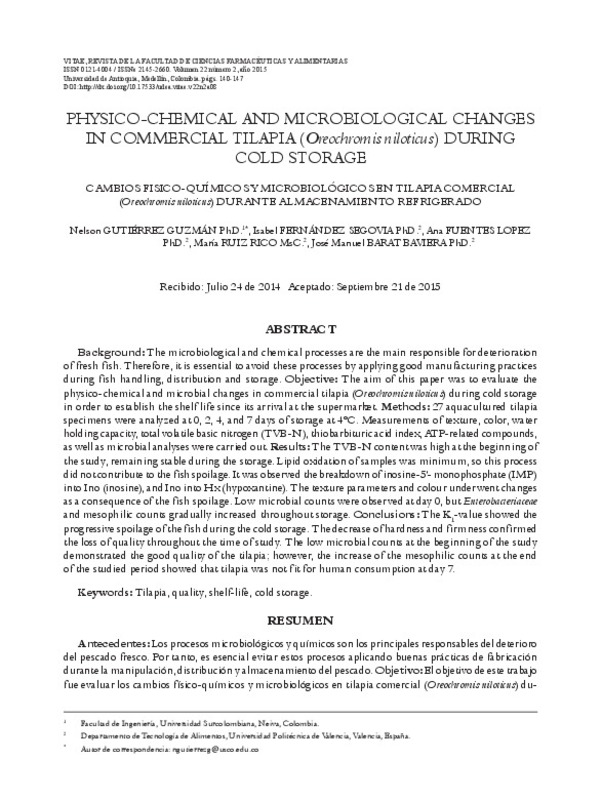JavaScript is disabled for your browser. Some features of this site may not work without it.
Buscar en RiuNet
Listar
Mi cuenta
Estadísticas
Ayuda RiuNet
Admin. UPV
Physico-chemical and microbiological changes in commercial tilapia (Oreochromis niloticus) during cold storage
Mostrar el registro sencillo del ítem
Ficheros en el ítem
| dc.contributor.author | Gutiérrez Guzmán, Nelson
|
es_ES |
| dc.contributor.author | Fernández Segovia, Isabel
|
es_ES |
| dc.contributor.author | Fuentes López, Ana
|
es_ES |
| dc.contributor.author | Ruiz Rico, María
|
es_ES |
| dc.contributor.author | Barat Baviera, José Manuel
|
es_ES |
| dc.date.accessioned | 2017-03-23T07:30:40Z | |
| dc.date.available | 2017-03-23T07:30:40Z | |
| dc.date.issued | 2015 | |
| dc.identifier.issn | 0121-4004 | |
| dc.identifier.uri | http://hdl.handle.net/10251/78980 | |
| dc.description.abstract | [EN] The microbiological and chemical processes are the main responsible for deterioration of fresh fish. Therefore, it is essential to avoid these processes by applying good manufacturing practices during fish handling, distribution and storage. Objective: The aim of this paper was to evaluate the physico-chemical and microbial changes in commercial tilapia (Oreochromis niloticus) during cold storage in order to establish the shelf life since its arrival at the supermarket. Methods: 27 aquacultured tilapia specimens were analyzed at 0, 2, 4, and 7 days of storage at 4ºC. Measurements of texture, color, water holding capacity, total volatile basic nitrogen (TVB-N), thiobarbituric acid index, ATP-related compounds, as well as microbial analyses were carried out. Results: The TVB-N content was high at the beginning of the study, remaining stable during the storage. Lipid oxidation of samples was minimum, so this process did not contribute to the fish spoilage. It was observed the breakdown of inosine-5’- monophosphate (IMP) into Ino (inosine), and Ino into Hx (hypoxantine). The texture parameters and colour underwent changes as a consequence of the fish spoilage. Low microbial counts were observed at day 0, but Enterobacteriaceae and mesophilic counts gradually increased throughout storage. Conclusions: The K1-value showed the progressive spoilage of the fish during the cold storage. The decrease of hardness and firmness confirmed the loss of quality throughout the time of study. The low microbial counts at the beginning of the study demonstrated the good quality of the tilapia; however, the increase of the mesophilic counts at the end of the studied period showed that tilapia was not fit for human consumption at day 7. | es_ES |
| dc.description.abstract | [ES] Antecedentes: Los procesos microbiológicos y químicos son los principales responsables del deterioro del pescado fresco. Por tanto, es esencial evitar estos procesos aplicando buenas prácticas de fabricación durante la manipulación, distribución y almacenamiento del pescado. Objetivo: El objetivo de este trabajo fue evaluar los cambios físico-químicos y microbiológicos en tilapia comercial (Oreochromis niloticus) durante el almacenamiento refrigerado con el fin de establecer la vida útil desde su llegada al supermercado. Métodos: 27 especímenes de tilapia fueron analizados a día 0, 2, 4 y 7 de almacenamiento a 4 ºC. Se llevaron a cabo medidas de textura, color, capacidad de retención de agua, nitrógeno básico volátil total (N-BVT), índice del ácido tiobarbitúrico, compuestos relacionados con el ATP, así como análisis microbianos. Resultados: El contenido en N-BVT fue alto al principio del estudio, siendo estable durante el almacenamiento. La oxidación lipídica de las muestras fue mínima, por lo que este proceso no contribuyó al deterioro del pescado. Se observó la degradación de inosina-5’- monofosfato (IMP) a Ino (inosina), y de Ino a Hx (hipoxantina). Los parámetros de textura y color sufrieron cambios como consecuencia del deterioro del pescado. Se observaron bajos recuentos microbianos a día 0, pero los recuentos de Enterobacteriaceae y de mesófilos aumentaron gradualmente durante el almacenamiento. Conclusiones: El valor K1 mostró el deterioro progresivo del pescado durante el almacenamiento en refrigeración. La disminución de dureza y firmeza confirmó la pérdida de calidad a lo largo del tiempo de estudio. Los bajos recuentos microbianos al principio del estudio demostraron la buena calidad de la tilapia; sin embargo, el aumento de los recuentos de mesófilos al final del periodo estudiado mostraron que la tilapia no era adecuada para el consumo humado a día 7. | es_ES |
| dc.language | Inglés | es_ES |
| dc.publisher | Universidad de Antioquía-Facultad de ciencias farmacéuticas y alimentarias | es_ES |
| dc.relation.ispartof | Revista Vitae | es_ES |
| dc.rights | Reserva de todos los derechos | es_ES |
| dc.subject | Tilapia | es_ES |
| dc.subject | Quality | es_ES |
| dc.subject | Shelf-life | es_ES |
| dc.subject | Cold storage | es_ES |
| dc.subject | Calidad | es_ES |
| dc.subject | Vida útil | es_ES |
| dc.subject | Almacenamiento refrigerado | es_ES |
| dc.subject.classification | TECNOLOGIA DE ALIMENTOS | es_ES |
| dc.title | Physico-chemical and microbiological changes in commercial tilapia (Oreochromis niloticus) during cold storage | es_ES |
| dc.type | Artículo | es_ES |
| dc.identifier.doi | 10.17533/udea.vitae.v22n2a08 | |
| dc.rights.accessRights | Abierto | es_ES |
| dc.contributor.affiliation | Universitat Politècnica de València. Departamento de Tecnología de Alimentos - Departament de Tecnologia d'Aliments | es_ES |
| dc.contributor.affiliation | Universitat Politècnica de València. Escuela Técnica Superior de Ingeniería Agronómica y del Medio Natural - Escola Tècnica Superior d'Enginyeria Agronòmica i del Medi Natural | es_ES |
| dc.description.bibliographicCitation | Gutiérrez Guzmán, N.; Fernández Segovia, I.; Fuentes López, A.; Ruiz Rico, M.; Barat Baviera, JM. (2015). Physico-chemical and microbiological changes in commercial tilapia (Oreochromis niloticus) during cold storage. Revista Vitae. 22(2):140-147. doi:10.17533/udea.vitae.v22n2a08 | es_ES |
| dc.description.accrualMethod | S | es_ES |
| dc.relation.publisherversion | http://dx.doi.org/10.17533/udea.vitae.v22n2a08 | es_ES |
| dc.description.upvformatpinicio | 140 | es_ES |
| dc.description.upvformatpfin | 147 | es_ES |
| dc.type.version | info:eu-repo/semantics/publishedVersion | es_ES |
| dc.description.volume | 22 | es_ES |
| dc.description.issue | 2 | es_ES |
| dc.relation.senia | 296746 | es_ES |
| dc.identifier.eissn | 2145-2660 |








